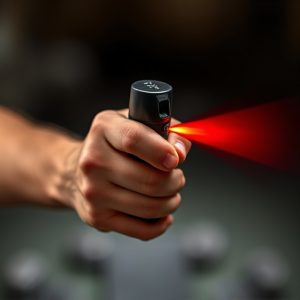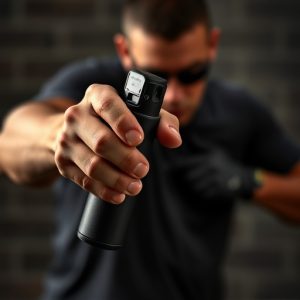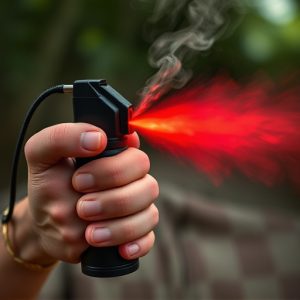Riot Control Agents: Science, Law, and Best Practices for Effectiveness
Riot control agents like pepper spray are chemical tools for law enforcement to manage crowds during…….
Riot control agents like pepper spray are chemical tools for law enforcement to manage crowds during unrest, with pepper spray being the most common due to its quick-acting capsaicin irritant. The active ingredient causes pain and disorientation, lasting 20-45 minutes, though this varies based on weather and individual sensitivity. Law enforcement must balance effectiveness with proportionate force, adhering to legal guidelines that dictate deployment duration and conditions. Proper training and drills are crucial for safe and effective use while protecting both officers and civilians, ensuring these agents serve as a last resort.
Riot control agents, including pepper spray, are essential tools for law enforcement facing civil disturbances. This article delves into the world of these powerful tools, exploring their types, mechanisms, and legal considerations. We uncover the science behind pepper spray, its lasting effects on understanding how long it remains active (a crucial question), and best practices for safe handling. By examining the legal framework, we aim to provide a comprehensive guide for law enforcement in navigating the deployment of riot control agents effectively and responsibly.
- Understanding Riot Control Agents: Types and Their Roles in Law Enforcement
- The Science Behind Pepper Spray: Active Ingredients and Mechanisms of Action
- How Long Does Pepper Spray Last? A Comprehensive Overview
- Legal Framework and Regulations Surrounding Riot Control Agent Use
- Best Practices for Law Enforcement: Safe Handling and Deployment Techniques
Understanding Riot Control Agents: Types and Their Roles in Law Enforcement
Riot control agents, often referred to as less-lethal weapons, are chemical substances designed to disrupt and disperse crowds or individuals involved in civil unrest or violent demonstrations. These agents play a significant role in law enforcement by providing an alternative to deadly force, offering a tactical advantage during high-risk situations. The types of riot control agents include pepper spray, tear gas, and smoke bombs, each with distinct properties and applications.
Pepper spray, one of the most commonly used agents, is known for its quick-acting irritant that temporarily blinds and disorients the target, making it an effective tool for crowd control. The effect of pepper spray lasts for a relatively short period, typically ranging from 20 to 45 minutes, after which individuals can regain their normal vision and sensory functions. This temporary disability allows law enforcement to gain control of chaotic situations, ensuring officer safety and minimizing potential harm to the public.
The Science Behind Pepper Spray: Active Ingredients and Mechanisms of Action
The science behind pepper spray, also known as oleoresin capsicum (OC) spray, lies in its active ingredient: capsaicin. Derived from chili peppers, capsaicin is a powerful irritant that targets the human body’s sensory system. When sprayed, it activates nerve endings in the eyes, nose, and respiratory tract, leading to a range of physiological responses. These include immediate pain, tearing up, and difficulty breathing, making pepper spray an effective tool for law enforcement during crowd control or when dealing with resistant individuals.
The duration of pepper spray’s effects varies but is typically designed to incapacitate a subject for several minutes, giving officers enough time to gain control. How long it lasts can depend on factors such as the concentration of capsaicin, weather conditions (humidity and temperature), and the target’s individual tolerance or sensitivity. Understanding these mechanisms is crucial for law enforcement agencies to ensure they use pepper spray responsibly and proportionately in compliance with legal guidelines, while also prioritizing the safety of both officers and citizens.
How Long Does Pepper Spray Last? A Comprehensive Overview
Pepper spray, a common riot control agent used by law enforcement, has a duration of effect that varies based on several factors such as the concentration of capsaicin (the active ingredient), the type of sprayer, and environmental conditions. Studies indicate that pepper spray typically lasts for about 20 to 60 seconds, with its effectiveness waning rapidly after initial deployment. During this time, individuals affected will experience irritation, coughing, difficulty breathing, and temporary blindness—symptoms that can impair their ability to fight or escape.
However, the duration of effects is not consistent across all scenarios. Factors like wind speed and direction can significantly impact how long pepper spray remains active in the air, affecting its reach and potency. Additionally, individual sensitivity varies; those with pre-existing respiratory conditions or other health issues might experience longer-lasting effects. Understanding these variables is crucial for law enforcement agencies to ensure effective yet proportionate use of pepper spray during crowd control situations.
Legal Framework and Regulations Surrounding Riot Control Agent Use
The legal framework surrounding riot control agent use, such as pepper spray, is a complex web designed to balance public safety with individual rights. Laws and regulations vary by jurisdiction but generally govern the circumstances under which these agents can be deployed. Authorities must adhere to strict protocols, ensuring that the use of force, including chemical agents, is proportional to the threat and used as a last resort. Non-lethal weapons like pepper spray are often subject to specific guidelines outlining how long their effects should last and who can authorize their use.
For instance, many regions limit pepper spray to situations where less lethal force is appropriate, such as during civil unrest or when an individual poses a direct threat. The duration of pepper spray’s effects is also regulated, with laws dictating that it must wear off after a certain period to minimize long-term harm. These regulations aim to protect citizens from excessive use and ensure that law enforcement agencies maintain a level of accountability in their actions.
Best Practices for Law Enforcement: Safe Handling and Deployment Techniques
Law enforcement agencies must prioritize safety when employing riot control agents, ensuring both officers and civilians are protected. Best practices involve rigorous training in the safe handling and deployment of these substances. This includes understanding the specific properties of each agent, such as how long pepper spray effects last, to make informed decisions during high-pressure situations.
Officers should be trained to assess the threat level and choose the appropriate agent accordingly. Proper application techniques are crucial; for instance, aiming for the eyes and face with pepper spray can maximize its effectiveness while minimizing collateral damage. Regular drills and simulations help maintain proficiency and ensure officers remain calm under stress, leading to more effective riot control.
Riot control agents, especially pepper spray, have become essential tools in law enforcement, offering a safe and effective means of managing chaotic situations. Understanding these agents’ mechanisms, their legal boundaries, and best practices is crucial for ensuring public safety and minimizing adverse effects. With knowledge of the lasting impact of pepper spray, ranging from 30 minutes to several hours depending on factors like concentration and weather conditions (How Long Pepper Spray Effects Last), officers can strategically deploy these tools while adhering to strict regulations. By following safe handling techniques, law enforcement agencies can maximize the benefits of riot control agents while mitigating potential risks.


